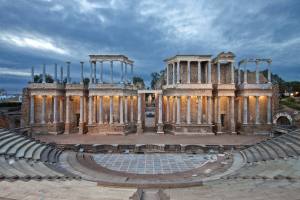Merida, the capital of Extremadura situated at the west of Spain, was founded by the romans during the I BC. There are still some things left of the roman empire like the roman theatre. Emerita Augusta was named UNESCO World Heritage in 1993.
Due to its great historical relevance there are many things you can see in the city. Here we have somo ideas for you during your stay in Merida:
Ancient Roman Theater and Amphitheater

The roman theater of Merida was buil between 16 and 15 BC. Some remodelations were made during the I century BC and between 333 and 337. When the christian religion became oficial during the Roman Empire, parts of the theater were destroyed or burried because theater was considered immoral. In 1910 started the archaeological excavations and in 1962 the reconstruction.
Every year, since 1933, during the months of july and august the International Festival of Classical Theater takes place here, considered one of the most important theater festivals. (https://www.festivaldemerida.es/).

The amphitheater is located just next to the theater. Due to the inscriptions found on its grandsand we know that it was build in 8 BC and was a perfec scenario for all kind of shows: Gladiator’s fights, hauntings, fights between wild animals…More that 15.000 could assist to each of those shows.
National Museum of Roman Art (MNAR)

Inside of the museum we can find one of the best collections of roman sculpture and mosaics of all Spain and we can also learn how functioned a big roman city during the Roman Empire.
The city center
In the ancient center of Merida we can find many interesting spots to visit and admire:
[metaslider id=411]
- Hot springs on Pontezuelas street
- Forum gateway
- Diana Temple
- Cultural Center Alcazaba
- Concathedral of Santa María
- Trajano Arch
- Carmen Church
Other things to see
- Roman Circus: one of the best preserved circus of all Empire.
- Aqueduct and the hot springs of San Lázaro/Rabo de Buey
- Xenodochium: with the remainings of an ancient Visigoths hospital
- Hot springs and snow well: roman remainings discovered in 1920 and said to be made for many applications: hot springs, baptistery,headquarters of some religion,glass fabric…
- “El acueducto de los milagros” (Miracle aqueduct): huge aqueduct that brought the watter supply to the city from Proserpina Dam
- Roman bridge: one of the longest at a time.
